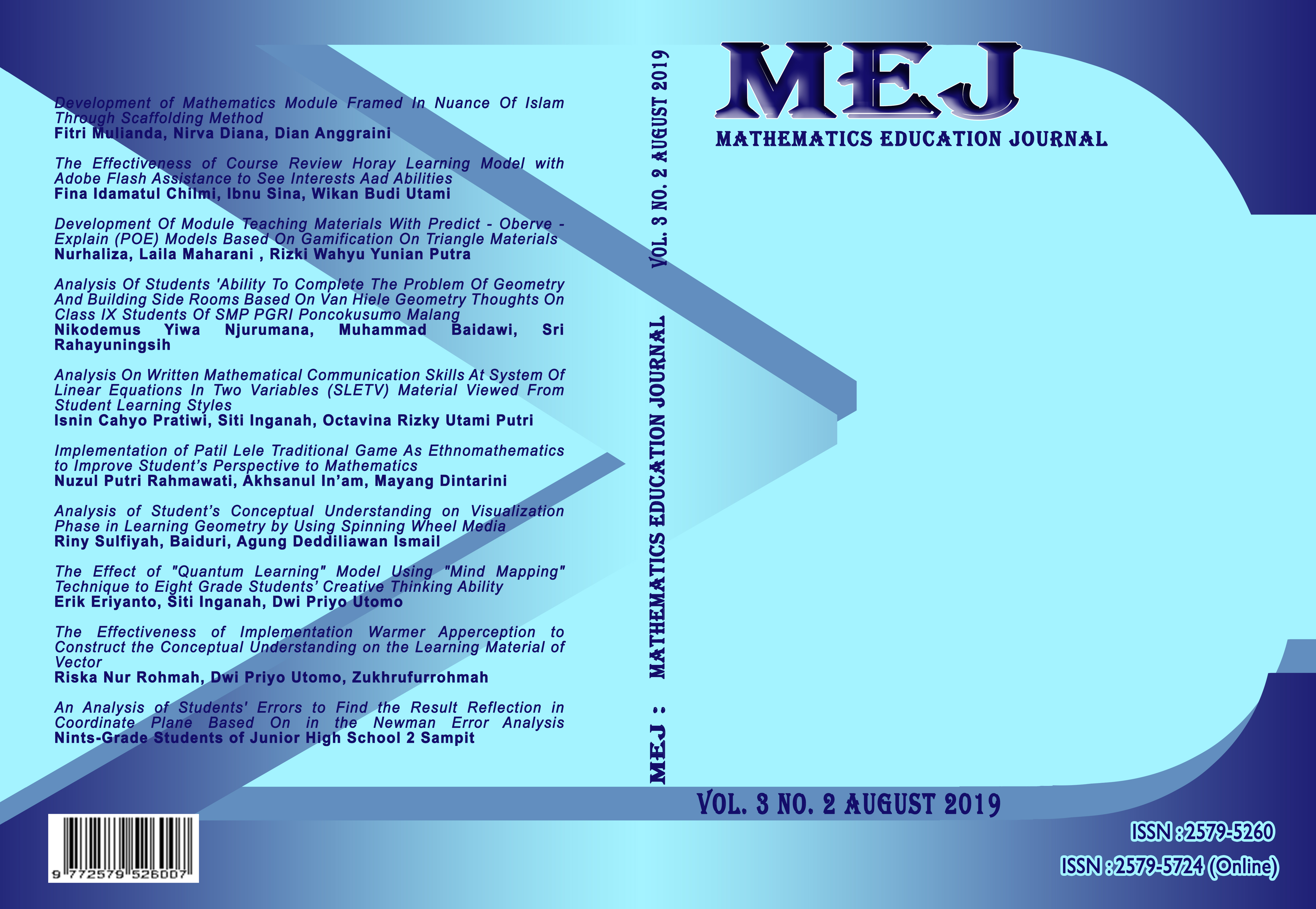The Effectiveness of Course Review Horay Learning Model with Adobe Flash Assistance to See Interests Aad Abilities
DOI:
https://doi.org/10.22219/mej.v3i2.11050Keywords:
Course Review Horay, Math Learning Stake, Ability Solution To Math Problem, Adobe FlashAbstract
Aim of this research to describe: 1) There are difference between math learning stake and ability solution to math problem which taught by Course Review Horay method Adobe Flashes aided, 2) Math learning stake and ability solution to math problem which taught by Course Review Horay method Adobe Flashes aided better than only Course Review Horay method. Data analysis technique that used are Right Side Proportion Test, T-tes One Right Side, Manova Test, and τ^2- Hotelling. Result of this research are: 1) There are difference between math learning stake and ability solution to math problem which taught by Course Review Horay method Adobe Flashes aided with only Course Review Horay method, 2) Math learning stake and ability solution to math problem which taught by Course Review Horay method Adobe Flashes aided better than only Course Review Horay method.Downloads
References
Amaliyakh, R., & Isnani, I. (2015). Efektivitas Strategi Pembelajaran Student Team Heroic Leadership (Sthl) Dan Pemberian Tugas Terstruktur Terhadap Ketuntasan Belajar Mahasiswa Dalam Matakuliah Analisis Real Di Program Studi Pendidikan Matematika Fkip Universitas Pancasakti Tegal. Jurnal Dialektika Program Studi Pendidikan Matematika, 2(2), 1-9.
Amelia, F., & Siahaan, F. H. (2016). Perbandingan Model Pembelajaran Kooperatif Tipe Course Review Horay Dengan Time Token Arends Terhadap Hasil Belajar Matematika Siswa Kelas Viii Di Smp Laksamana Batam Tahun Pelajaran 2014/2015. PYTHAGORAS: Jurnal Program Studi Pendidikan Matematika, 4(2).
Anisa, W. N. (2014). Peningkatan kemampuan pemecahan masalah dan komunikasi matematik melalui pembelajaran pendidikan matematika realistik untuk siswa smp negeri di kabupaten garut. Jurnal Pendidikan dan Keguruan, 1(1).
Auliya, R. N. (2013). Pengaruh Model Pembelajaran Kooperatif Tipe CRH (Course, Review, Hurray) Terhadap Kemampuan Pemahaman Matematis dan Kecemasan Matematika Siswa SMP (Doctoral dissertation, Universitas Pendidikan Indonesia).
Darari, M. B. (2017). Penggunaan Media Adobe Flash Pada Pembelajaran Kesebangunan Dalam Meningkatkan Kemampuan Pemecahan Masalah Matematika Siswa Smp Negeri 7 Medan. JURNAL HANDAYANI PGSD FIP UNIMED, 7(2), 29-37.
Duha, A. K. (2012). Penerapan Model Think Pair Share Terhadap Pemahaman Konsep. Jurnal Pendidikan Matematika, 1(1).
Eliyah, S., Isnani, I., & Utami, W. B. (2018). Keefektifan model pembelajaran course review horay berbantuan power point terhadap kepercayaan diri dan prestasi belajar. S-MAT (Jurnal Edukasi dan Sains Matematika), 4(2), 131-140.
Faz, Ahmad Toha. 2017. Matematika Detik “Insprirasi, Fondasi, dan Garis Besar”. Surakarta : PT. Aksarra Sinergi Media.
Kartana, Tri Jaka. 2014. Manajemen Pendidikan. Tegal: Badan Penerbitan Universitas Pancasakti.
Nurmavia, A. (2011). Diagnosis Kesulitan Belajar dan Pengajaran Remidinya Materi Bangun Ruang Sisi Datar Siswa Kelas VIII SMP Negeri 4 Kepanjen Kabupaten Malang. SKRIPSI Jurusan Matematika-Fakultas MIPA UM.
Simanungkalit, R. H. (2016). Pengembangan Perangkat Pembelajaran untuk Meningkatkan Kemampuan Pemecahan Masalah Matematis Siswa SMP Negeri 12 Pematangsiantar. MUST: Journal of Mathematics Education, Science and Technology, 1(1), 39-56.
Sholikhakh, R. A., Pujiarto, H., & Suwandono, S. (2019). Keefektifan Model Pembelajaran Problem Based Learning terhadap Minat dan Prestasi Belajar Matematika. Journal of Medives: Journal of Mathematics Education IKIP Veteran Semarang, 3(1), 33-39.
Slameto. 2010. Belajar dan Faktor-Faktor Yang Mempengaruhinya. Jakarta: Rineka Cipta.
Umam, K., & Yudi, Y. (2016). Pengaruh Menggunakan Software Macromedia Flash 8 Terhadap Hasil Belajar Matematika Siswa Kelas VIII. KALAMATIKA Jurnal Pendidikan Matematika, 1(1), 84-92.)
Downloads
Published
Issue
Section
License
Authors who publish with MEJ (Mathematics Education Journal) agree to the following terms:
For all articles published in MEJ, copyright is retained by the authors. Authors give permission to the publisher to announce the work with conditions. When the manuscript is accepted for publication, the authors agree to automatic transfer of the publishing right to the publisher.
Authors retain copyright and grant the journal right of first publication with the work simultaneously licensed under a Creative Commons Attribution-ShareAlike 4.0 International License that allows others to share the work with an acknowledgment of the work's authorship and initial publication in this journal.
Authors are able to enter into separate, additional contractual arrangements for the non-exclusive distribution of the journal's published version of the work (e.g., post it to an institutional repository or publish it in a book), with an acknowledgment of its initial publication in this journal.
Authors are permitted and encouraged to post their work online (e.g., in institutional repositories or on their website) prior to and during the submission process, as it can lead to productive exchanges, as well as earlier and greater citation of published work (See The Effect of Open Access).

This work is licensed under a Creative Commons Attribution-ShareAlike 4.0 International License.










